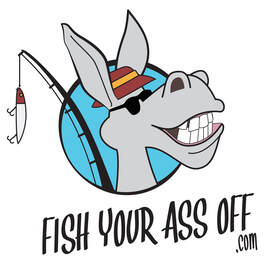
Is Inshore Fishing After Rain Any Good?
Yes, inshore fishing after it rains can be great depending upon the fish species you are targeting. Rain means temperature drops, barometric pressure drops and less light and you can take advantage of all of these conditions to target snook, tarpon, redfish and speckled trout.
I like to fish inshore right after it rains. When it is broiling hot in the summer months the cold rain can make lethargic inshore fish like snook, tarpon, redfish and speckled trout turn on and start munching.
Tarpon are especially good feeders after it rains. For some reason they really turn on after the rain stops and the upper layer of the water column starts to get glassy.
This is especially true when those storms end right before sunrise or right before sunset. Those low light scenarios are already a great time to fish for tarpon but when the end of the storm times out just right it can be epic....
The author of this article is a FISHING CHARTER CAPTAIN. He has been inshore fishing the grass flats, oyster bars and mangroves all over Florida for more than 40 years.
In the article below, we will talk more about fishing before, during and after it rains for snook, tarpon, redfish, speckled trout and more.
Let's get started.
Watch the video below to learn more about inshore fishing to help you catch more fish.
Yes, inshore fishing after it rains can be great depending upon the fish species you are targeting. Rain means temperature drops, barometric pressure drops and less light and you can take advantage of all of these conditions to target snook, tarpon, redfish and speckled trout.
I like to fish inshore right after it rains. When it is broiling hot in the summer months the cold rain can make lethargic inshore fish like snook, tarpon, redfish and speckled trout turn on and start munching.
Tarpon are especially good feeders after it rains. For some reason they really turn on after the rain stops and the upper layer of the water column starts to get glassy.
This is especially true when those storms end right before sunrise or right before sunset. Those low light scenarios are already a great time to fish for tarpon but when the end of the storm times out just right it can be epic....
The author of this article is a FISHING CHARTER CAPTAIN. He has been inshore fishing the grass flats, oyster bars and mangroves all over Florida for more than 40 years.
In the article below, we will talk more about fishing before, during and after it rains for snook, tarpon, redfish, speckled trout and more.
Let's get started.
Watch the video below to learn more about inshore fishing to help you catch more fish.
Inshore Fishing After Rain Basics
Rain is much hated by most outdoor enthusiasts. This means that hunters, hikers, kayakers, fishermen and many others can't stand the rain but this guy loves it.
The rain brings with it 3 important conditions:
1) It brings a temperature drop depending on where you live.
2) It brings a drop in the barometric pressure.
3) It brings a drop in the light levels.
Let's go over all three of these conditions and how they affect the inshore fishing after it rains.
Temperature Drops
The temperature drop can be very helpful when it is hot out. Fish are cold blooded like a snake or an alligator. This means that for their bodies and metabolisms to work efficiently they have to use their outer environments to manage their body temperatures.
When it is smoking hot and you are fishing inshore in shallow waters you can count on those snook, tarpon, speckled trout, redfish, flounder...... seeking cooler water.
The rain can bring much wanted relief for those inshore species of fish. Fish just can't hunt effectively if they are too hot. AND hot water can't hold dissolved oxygen as well as cold water can.
This means that these fish can't breathe well and can get overheated if they are not careful. Ice cold rain can fix these problems. The drops can force atmospheric oxygen into the water column and the cold can turn the fish on to get some lunch.
Barometric Pressure Drops
Barometric Pressure Drops makes many species of fish uncomfortable because their swim bladders will expand. Those fish will usually head to deeper water because the extra water pressure will keep their bladders from expanding too much.
Not every fish has a large swim bladder. The fish with the smaller swim bladders seem to be affected less by barometric pressure caused by the rain storms.
Fish can feel the rain coming so they will often feed heavily before the storm. As the storm passes the barometric pressure will begin to rise and the fish will come out of their deeper inshore holes and channels to head to shallow water.
Then they will start to feed again after the storm passes.
Low Light Levels
Predators like low light scenarios because it helps them catch prey. That is why sunrise and sunset are two of the best times of day to go inshore fishing.
Clouds are a good thing for inshore fishing. Those predators will take advantage of the clouds to eat more prey items. You can take advantage of the clouds too because you can more easily trick those predators to eat your baits and lures.
Inshore Fishing After Rain and the Water Column
Fish Deep at First
So we know that inshore fish tend to move deep when the barometric pressure is low. This means that you should start in the deeper channels and drop offs after a rain storm moves through.
You will want to use your best deep water fishing lures like jigs to target your preferred fish species. You can also use cut bait and live bait in this deeper water.
WANT TO CATCH SNOOK, REDFISH, TROUT AND TARPON? BOOK YOUR FISHING CHARTER TODAY!
Best Lures
I like to fish with jigs for inshore fish after a storm. You will need to find a good size of jig depending upon the current and depth of where you are fishing. A flair hawk style of jig between 2 1/2 ounces and one ounce will work when the water is deeper than 8 feet or so and there is current to deal with.
I wrote another article like this one on this website that covers in great detail how to fish with a flair hawk style of jig. You can see that article by clicking right here.
When the water is less than 8 feet you can usually get away with an 1/8 ounce up to a 1/2 ounce most of the time. When I fish in water less than 8 feet I usually go with a jig head with a paddle tail. That is my go to lure because every inshore species of fish will eat that lure and you can cover a lot of water with it.
Best Baits
My preferred inshore fishing species are snook, tarpon, redfish and speckled trout. All of these species will readily eat a mullet head, or chunk of mullet on the bottom. Pinfish and ladyfish are also good choices for dead bait fishing after it rains.
Just make sure to cut the chunks so that they are too big for hard head catfish and sail catfish to eat. For some reason catfish can find your dead bait before the fish that you are actually targeting can.
Learn more about inshore fishing for speckled trout with dead baits in the video below.
Fish Shallow After the Rain Passes
Once the rain passes and the water has had a chance to cool and the barometric pressure begins to climb, the fish will begin to move into shallow water.
This all depends upon the strength of the rain storms of course. Some smaller storms bring a slight drop in barometric pressure. On the other end of the spectrum a hurricane will cause the pressure to crash and the fish may not feed for a week.
BUT let's just assume that we are talking about a random rain storm and not anything extreme.
The inshore waters will often get real glassy after the rain passes through. This is a great time to fish in shallower water with top water fishing lures.
During the rain, the surface tension of the water is continually broken and the fish cannot use their lateral lines to find prey efficiently. The lateral line lets inshore predatory fish find prey by tracking their vibrations as they move through the water.
Rain causes vibrations that make it difficult for inshore fish species like, snook, tarpon, speckled trout and redfish track down some food. Once the wind and the rain ends the lateral line can get its job done and track some prey items.
A noisy lure that puts out a ton of vibrations will attract predatory fish from a long way when the inshore surface waters are calm and glassy. I like to use a walk the dog type of top water lure like a Zara Spook or a MirrOLure Top Dog.
*I am not sponsored by any lure company. I only talk about lures that I use.
Watch the video below to see redfish action with walk the dog top water lures.
What are the best inshore fishing lures to use when it is raining?
Top Water Lures- The only lures that you shouldn't use when it is raining are top water lures unless they can make more vibrations than the rain drops are sending out. A concave faced popping lure is probably your best bet if you absolutely insist upon doing some top water inshore fishing during the rain. BUT it is better to fish in the lower parts of the water column.
It is hard to get a fish's attention on the water's surface when it is raining so go deeper. Like I mentioned earlier in this article, jigs are a great lure to choose for fishing the deeper parts of the water column.
Paddle Tails- Go out and get yourself some 3 inch soft plastic paddle tails and some 5 inch soft plastic paddle tails. You will want to couple these with either a weighted weed less hook or an appropriately weighted jig head.
You can either swim these lures in different parts of the water column until you figure out where the fish are.
Spoons- Another great inshore lure to fish when it is raining is a spoon. Spoons are one of those lures that catches just about everything. Spoons send out a ton of vibrations and only need a little bit of light to reflect off of their gold or silver finishes.
Conclusion:
Many fishermen do not bother fishing on rainy days because it is harder to fish inshore. BUT you might be missing out on some amazing inshore fishing opportunities.
Many fish will feed right after the rain storms pass as long as they are not extreme low barometric pressure events. You can catch tarpon, snook, redfish, speckled trout, flounder, black drums, bluefish, mackerel and many more species after it rains.
You just have to figure out where in the water column the fish are and get your baits or lures to that place. Make sure that your tackle box is full of lures that can fish the entire water column.
Do you like how to fishing articles like this one? If you answered yes, then sign up for our email list below and we will send you one new fishing article every week.
Sign up now and get your first one in a few minutes.
